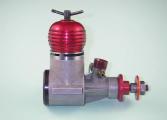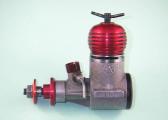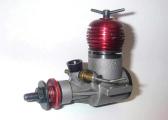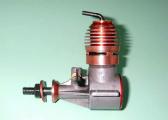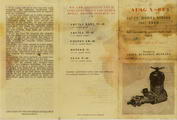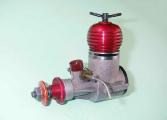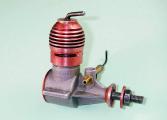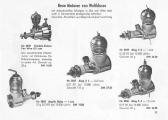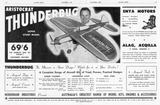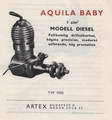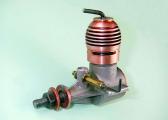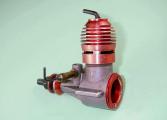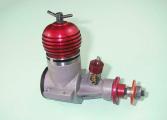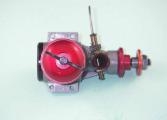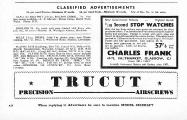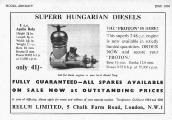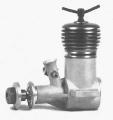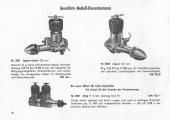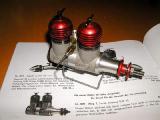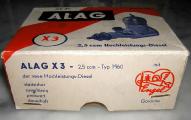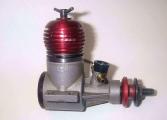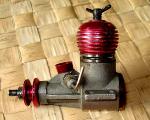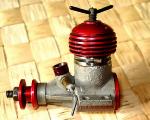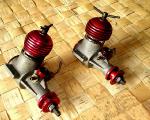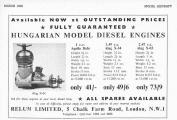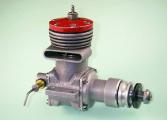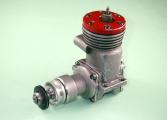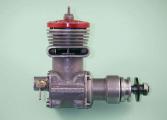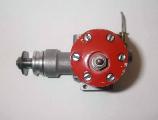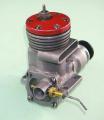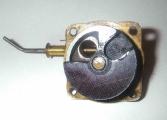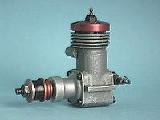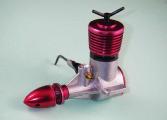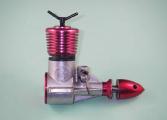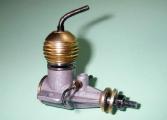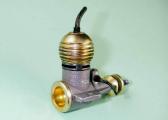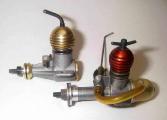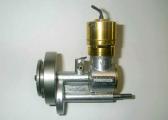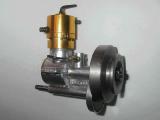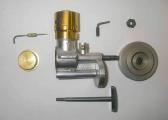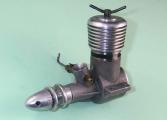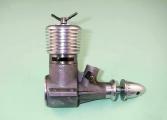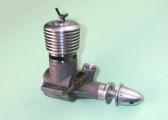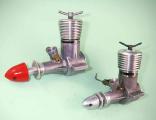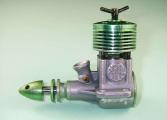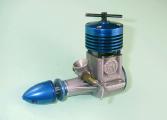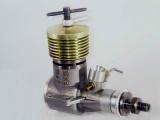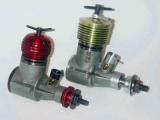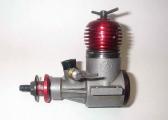The Alag/Vella Brothers Story
(Defending the Indefensible)
by Adrian Duncan
2011-05
Revised:
2011-06
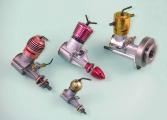 |
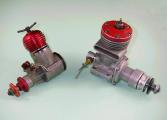 |
|
|
Click on images to view larger picture,
hover over the images for a description. |
||
-
 In The Beginning
In The Beginning -
 The V.T. 8 Aquila Baby
The V.T. 8 Aquila Baby -
 The Alag X-3
The Alag X-3 -
 The Alag X-3 On Test
The Alag X-3 On Test -
 The Alag X-4
The Alag X-4 -
 The Validity of Warring's Test Reports
The Validity of Warring's Test Reports -
 The Alag Y-2
The Alag Y-2 -
 The Other V.T Engines
The Other V.T Engines -
 The V.T. 9
The V.T. 9 -
 The V.T. 0.25
The V.T. 0.25 -
 The V.T. 12 Seal Baby
The V.T. 12 Seal Baby -
 The Engel Rebell Models
The Engel Rebell Models -
 A Final Fling—The BX Engines
A Final Fling—The BX Engines -
 The End of the Line
The End of the Line -
 A Direct Descendant?
A Direct Descendant? -
 Conclusion
Conclusion
During my long-ago teenage years—more years ago in fact than anyone who still "plays with toy airplanes" should be prepared to admit!—I was forced to support my aeromodelling addiction on a somewhat less-than-optimal budget. My sources of disposable income at that time were limited to a few bob a week pocket money from my parents plus the odd bit of extra cash earned now and then by playing music in a local pop group and doing the "bob-a-job" routine for a few of the better-heeled or perhaps more sympathetic neighbours.
Under these circumstances, such luxuries as new engines were generally well beyond my means. I started out in the late '50's using beat-up but still serviceable fourth-hand examples of the D-C Merlin and the Frog 80, and my first new model engine was a Series 2 E.D. Bee which I received from my parents for my 12th birthday in 1959. But apart from that, I was pretty much on my own since my parents elected to support my musical interests rather than my modelling ones—which they wrongly assumed that I would soon outgrow.
During the first half of the 1960's, this situation resulted in my being constantly on the lookout for bargain-priced used engines, which were far more plentifully and cheaply available in those golden pre-collector years than they are today. At that time, I was not a collector in any sense—in fact, the very concept of engine collecting had yet to present itself. I was simply an active but impecunious teenage flyer who needed serviceable and affordable second-hand engines. Many of those which came along are regarded as prized collector's items today and packrat that I am, I still have the majority of them!
Accordingly, when I had separate chances in quick succession to pick up a couple of used engines of Hungarian origin in pretty good condition at very reasonable prices, I seized the opportunities gratefully. These were a 2.5 cc Alag X-3 diesel and an example of its smaller relative, the Alag X-4 of 1.5 cc displacement. The fact that the engines originated from behind the then-mysterious Iron Curtain added a certain allure to their acquisition—I always enjoyed flying something "different"!.
I had first become aware of these engines from reading about them in the modelling press. I knew that they had been imported into Britain in relatively small quantities during the late 1950's and had been the subject of two quite favourable reviews by Ron Warring which had appeared in Aeromodeller magazine, to which I was then a subscriber (another birthday gift from my parents). As a result, a number of Alag engines had found their way into the hands of British modellers, including those of several active flyers in my area. This latter fact had provided me with the opportunity of seeing a few examples in actual use, and the owners of these engines were continuing to use them without apparent problems.
It should be clear from the above that I had no reason at the time to question the basic serviceability of the Alag diesels. It was only many years later that I became aware that by the early 1960's (when I purchased my two used engines), the Alags had already acquired a thoroughly evil reputation worldwide, being generally considered to be so poorly made as to be basically un-useable. Presumably as a result of this, their importation to Britain had ceased by 1960 and many of them appear to have gone out with the rubbish! This probably explains their relative scarcity today.
But none of our very small and somewhat isolated group of South Yorkshire-area Alag owners knew any of this—certainly, we were not aware that these engines were un-useable! Consequently, we just went ahead and used them, with perfectly satisfactory results. I'm sure that if we'd realised how bad they really were, we'd have followed the lead of modellers all over the world and thrown them into the rubbish bin! But we didn't—instead, we just enjoyed flying them in blissful ignorance of their many flaws!
For the benefit of potential present-day users, it's probably worth recalling one flaw that we did notice. This was the fact that the fitting of the prop driver taper on several examples was set so that there was excessive end-float on the shaft when the engine was assembled. The result was that the crankpin and rod big end were free to bear directly on the backplate when the shaft was moved towards the rear. Not a problem in normal use, but the plastic backplate would not do well in a pusher installation or in a crash in which the shaft was knocked back—excessive wear or an outright fracture of the backplate would be the almost inevitable result.
The cure that we adopted was the fitting of a steel shim behind the prop driver so that the shaft could not move back to the point where the crankpin made contact with the backplate. I'd recommend this modification to any present-day user of an Alag displaying this characteristic. A more elegant alternative for those having the equipment is to re-cut the 22 degree included angle taper inside the prop driver to adjust the clearance to around 10 thou end float when assembled. This latter approach has the added benefit of increasing the available length of prop mounting thread, which is a bit marginal on these engines.
After a period of about two years, I was able to obtain several similar-displacement British engines of higher performance and was quite happy to sell my still-serviceable Alags as a pair to another impecunious modeller who needed some cheap 'n cheerful engines for basic sport flying. He carried on using them for some time thereafter, and was still doing so when I left England for Canada in 1966. I don't know what became of them thereafter.
Many years later, when I was settled in Canada and had entered my "collector" period, I successively encountered a number of engines from the same manufacturing source, including several more examples of the X-3. Both of these appear to be just as serviceable as my original example had been, and I test-ran and flew the more "experienced" of the two for old time's sake while preserving the other in seemingly un-run "as new" condition. Other products of the same manufacturer that I subsequently acquired proved just as serviceable on testing, and I thus remained in complete ignorance of the universal contempt in which these engines were apparently held! It was only when I began to write up this article in consultation with others that I realized that I appear to be almost alone today in being a satisfied Alag owner/user!
I fully accept the truth of this situation, but I can only write about these engines at first hand on the basis of my own encounters with them. In the case of the Alag range, my experiences (and those of my club-mates) appear to be more or less unique, and this must be recognized at the outset. So with that qualification out in the open, here's my summary of the Alag story as I myself have experienced it. I can only wish that others had been similarly favoured.
In The Beginning
Our greatest reward for the considerable effort involved in the preparation of these articles is the receipt of additional information from readers following their initial publication. In the present instance, we were delighted to hear from our friend and colleague Maris Dislers, who was able not only to provide us with additional documentation but also to point out several avenues for further research. Our indebtedness to Maris cannot be overstated.
One of the documents supplied by Maris was a guarantee card from his NIB 1957 Alag X-3 (of which much more below). This card clearly gave the name of the group responsible for the Alag engines as the Alagi K�zponti Kis�rleti �zem (Alag Central Experimental Plant).
Here we clearly see the origin of the engine's name. Armed with this information courtesy of Maris, it was a simple matter to seek out further information on the Web. This generated a wealth of detail which has done much to clarify the origins of the Alag range. Our sincere thanks to Maris for drawing our attention to this fruitful line of inquiry!
The facility at which the Alag engines seem to have been made, or at least designed, had its origins in the field of full-size sport-flying aircraft. Sport flying using both gliders and powered aircraft had apparently been quite popular in Hungary prior to WW2, with a number of very active aero clubs. At that time, Hungary was very much allied with the Axis powers in Europe, relying increasingly upon trade with Nazi Germany and Fascist Italy to pull itself out of the Great Depression of the 1930's. Although reluctant to actually involve itself in all-out war, the country was inevitably drawn into the conflict, being directly involved on the Axis side in the 1941 invasions of both Yugoslavia and the Soviet Union.
The Hungarians subsequently became disenchanted with the direction that the war was taking and attempted to negotiate secretly on their own account with Britain and the USA. The German discovery of these initiatives led to the country being occupied by the Nazis in 1944. This occupation lasted until April of 1945, after which further negotiations with the Allied powers led to the establishment of the "Second Republic of Hungary" on February 1st, 1946.
These events had of course left the country's sport-flying resources in a shambles. Some measure of the importance attached to this activity may be gauged from the fact that steps were taken as rapidly as possible after the war to start rebuilding the sport-flying movement in Hungary. The role of this activity in producing potential military fliers doubtless influenced this decision.
Until June 1947, the Control Commission of the Allied powers imposed a complete ban on all sport-flying in Hungary. However, immediately upon the lifting of that ban, the Hungarians moved vigorously to re-establish sport-flying on an organized basis. In early 1948 a new organization called Orsz�gos Magyar Rep�l� Egyes�let (OMRE - National Hungarian Flying Association) was created to administer all sport-flying activity in Hungary. All existing aero clubs along with all their assets were incorporated into this new organization, and all sport airfields were managed and financed by OMRE in addition.
A number of aircraft suitable for sport-flying, both gliders and powered designs, had survived the ravages of war, but repairs and upgrades to these were urgently needed. In addition, a number of incomplete aircraft were awaiting completion. On top of this, new aircraft were urgently required to meet the needs of the revitalized movement.
To deal with the required restoration, maintenance and repair work, new workshops were founded, among them the OMRE K�zponti Rep�l�g�pjav�t� �zem, Buda�rs (OMRE Central Aircraft Repair Plant, Buda�rs) in June, 1948. The airfield at Buda�rs immediately became the central sport-flying airfield for OMRE. Of course, new designs were also required, and a central design office was also established to develop all the necessary documentation, restoration and repair programs required.
OMRE was quite successful in meeting its goals, and its success drew government attention to its potential. This led to the assets and mandate of OMRE being taken over by a new group called the Magyar Rep�l� Sz�vets�g (MRSz - Hungarian Aeronautical Association). Part of the plant at Buda�rs, which was then engaged in building new aircraft, was moved to M�ty�sf�ld airport in 1951. The other part of the plant was taken over by the Hungarian military.
The remaining MRSz plant at Buda�rs was relocated in 1952 to a newly-constructed sport flying airfield at Dunakeszi, a town lying just to the north of Budapest but still within the Budapest metropolitan area. It is here that the Alag story really has its beginnings.
The relocated MRSz plant and associated design office was very successful in developing and manufacturing a series of gliders as well as undertaking modifications to powered aircraft suitable for glider towing and flight training purposes. The success of the operation eventually led to yet another take-over, this time by the Koh� �s G�pipari Miniszterium (Ministry of Metallurgical and Mechanical Industry). This take-over occurred in March 1955, and the resulting government-run facility was designated the Alagi K�zponti Kis�rleti �zem (AKK� - Alag Central Experimental Plant). This of course is the facility identified on the Alag X-3 guarantee card referenced earlier.
It's unclear how the AKK� operation at Dunakeszi became involved with model engine production. In all probability, the initiative had something to do with a desire on the part of government to advance interest in aviation through involvement with aeromodelling. Someone within the Ministry likely realized that future sport-fliers, military pilots and aircraft designers may well develop from keen aero-modellers! The Soviet Union certainly pursued such a policy using existing aircraft-related facilities.
The actual design of the 2.46 cc Alag X-3 diesel, apparently the first model engine to bear the Alag name, is credited to different individuals by different authorities. According to Jiri Kalina in his well-known Czechoslovakian book on model engines ("Model�?sk� Motory", page 173), the engine was designed by one Laszlo Kuna, about whom I can find no further details. However, the noted authority on 2.5 cc (.15 cu. in.) model engines Jim Dunkin credits the design to Glula Krizsma, designer of the famous Krizsma Record 2.5 cc diesel. We are unable to confirm either accreditation from our own knowledge, and therefore confine ourselves to reporting these two published views.
The March 1955 date of the establishment of AKK� is highly significant because it clearly establishes an earliest-possible date for the introduction of the Alag model engine range. Kalina states that production of the Alag range commenced with the X-3 diesel in 1955. This date is undoubtedly consistent with the date of the establishment of the AKK� facility at Dunakeszi. As such, we feel that it may safely be accepted.
The above account appears to establish beyond doubt that at least the design of the Alag X-3 originated with AKK�. It's entirely possible that the initial manufacture of the engines also took place there - the appearance of the facility's name on the guarantee card certainly suggests this. However, it is an undeniable fact that the manufacture of model engines was an activity which was very far removed from the design and manufacture of gliders which was the facility's main function. Model engine manufacture required completely different tooling as well as different employee skills.
For this reason, it's also possible that having designed the engine, the Alag management looked around for an outside manufacturer to actually produce their design under contract. Even if they did not do so initially, there's no doubt that at some point the manufacture of the Alag range was taken up by the Vella brothers, Andras and Geza, who also produced engines simultaneously under their own initials of V.T. (standing for Vella Testverek, or Vella Brothers) and later added both the Engel Rebell and the now-obscure BX lines to their list of products. They may also have had a hand in the manufacture of the Proton engines, although this is very far from being an established fact.
The multiplicity of names under which the Vella brothers produced different engine lines implies that they operated as contract manufacturers for others in addition to turning out their own V.T. line. They certainly did so in the case of the Engel Rebell range, and their involvement with the Alag models may also have had a contractual basis. Whatever the facts of the matter, the concurrent use of different trade-names on their various product lines makes it a challenge to keep track of their activities at any given time.
It has been frequently stated in the past that the Vella Brothers also produced a line of engines under the Aquila trade-name. However, this statement is questionable. The main basis for this long-held belief appears to be the existence of the Aquila Baby 1 cc diesel (of which more below), which was exported to Western markets for some years in the mid to late 1950's and became quite well-known as a result. However, this engine was actually identified on the case as a V.T. product, and it thus appears that the name "Aquila Baby" was in fact simply the name of the model rather than the name of a line of engines. Certainly, the marine version of this engine was called the "Seal Baby" (again, more info below) and was also designated as a V.T. product, both on the case and in the packaging. I have been unable to uncover any direct evidence that any of these engines were ever packaged and sold as "Aquila" products—there's just the "Aquila Baby" model. I'd welcome any enlightenment which may be available from others more knowledgeable than I!
It's certainly true that a 1957 list of Hungarian model engines offered by ARTEX, who were the distributors of the Alag range, included an engine called the Aquila V.T. 7 of 5 cc displacement. This list appears as part of the instruction sheet for a 1957 Alag X-3 diesel. However, the 5 cc Aquila was also identified as a V.T. product, leaving the question of whether or not the Aquila name should be recognized as a distinct brand-name very much open to question in my personal view. Interestingly, the Alag X-4 (of which more below) which also appeared on this 1957 list was not identified as a V.T. product, seemingly supporting the idea that the Alag engines were in fact manufactured by others at this stage.
What's more likely si that the engines were initially manufactured at the AKK� workshops at Dunakeszi. However we have Peter Chinn's word for it the Vella brothers did become involved at some point, either initially or later. Perhaps domestic demand or competing work pressures outstripped the ability of the AKK� workshops to produce the engines on their own and they turned to the Vella brothers to rectify this situation through some kind of manufacturing contract? Alternatively, it could have been the move by the Hungarian foreign trading organization ATREX to promote International sales of the Alag engines that mandated an increase in production which the AKK� workshops were unable to meet without help. Finally, it's perfectly possible that the AKK� design office merely designed the engine and contracted its manufactured to the Vella Brothers from the outset. We'll probably never know.
The AKK� facility continued in operation until 1958, in which year it was wound up and the plant at Dunakeszi turned over to other purposes. It's pretty clear that this establishes a latest possible date for the involvement of the Vella brothers and that Alag engines made after that date were almost certainly manufactured by them as reported by Peter Chinn. They may well have produced the engines under contract to ARTEX, whose marketing efforts appear to have been unaffected by the closure of AKK�.
Whatever the facts may be regarding their involvement with the Alag range, it is certain that by 1955 the Vella brothers were producing the 1 cc Aquila Baby diesel, which was identified on the case as the V.T. 8. This was the first Vella Brothers product to be brought to the attention of modellers outside the Iron Curtain. This came about as a result of its being the subject of a test report by (presumably) Peter Chinn which was published in the June 1956 issue of Model Aircraft. More of this in its place below.
At the time of Chinn's analysis, ATREX had embarked upon a fairly aggressive campaign to market the Aquila Baby in a number of Western countries. By early 1957 they had added the Alag, Proton and Meteor ranges to their list and were promoting the distribution of those engines in England, Australia and several Western European countries. It may well have been this move that resulted in the Vella Brothers taking over the volume production of the Alag engines, perhaps under contract—again, we'll probably never know for sure.
It was undoubtedly the promotional activities of ATREX that resulted in the Alag engines becoming known for the first time beyond the Iron Curtain, and ATREX was successful in setting up agencies in several key market areas. Their initial agents in the UK were Ripmax Ltd of Camden Town, London. The first Ripmax ad for the Alag X-3 that has come to my attention appeared in the May 1957 issue of Model Aircraft, at which time the engine was being offered at a price of �3 15s 0d (�3.75 in modern money). For comparison purposes, it's worth noting that the price of the competing AM 25 at this time was �3 8s 6d (�3.42), so the Alag was at a slight price disadvantage in the context of the British market.
Sales in Germany were handled by the well-known Engel company, who were soon to enter into a manufacturing contract of their own with the Vella brothers. For detailed information on this aspect of the marketing of the Alag range, we are deeply indebted to Dr Walter Sturm of Roetgen, Germany. Walter has confirmed that the Alag engines were marketed by Engel (in English: "Angel") alongside a number of other engine ranges, including the Jaguar engines from Germany and the Cox and McCoy ranges from America. Interestingly enough, the Alag engines were sold in Engel's own boxes complete with German-language instructions.
In Australia, the Alag distributor was Bill Evans, a well-known model flyer of the time who may have imported them solely to throw sand in the bearings of the domestic engine manufacturing activities of the late Gordon Burford. Evans had exclusively distributed Burford's Gee Bee range, but a dispute arose over ownership of the name, giving rise to Burf abandoning "Gee Bee" and adopting Sabre for his engine range (Burf did not have a good run on names as his use of Sabre also led to dispute, so he changed to Taipan, and Glow Chief for his engines). The story goes that Bill Evans showed Gordon a bag of engines which were "...going to put him out of business". Burf needn't have worried—Evans appears to have got a very bad batch and few if any of the Alags imported to Australia by Evans were supplied in running condition, leading to their acquiring such a bad reputation Downunder that it lasts to this day!
Both diesel and glow engines were produced under the Alag designation. The Alag diesel engines were designated by the letter X followed by a number indicating the particular model. The glow engines were designated by the letter Y followed by a model number. The model number bore no relation to the engine's displacement. The application of serial numbers to these engines appears to have been a bit haphazard—some have numbers while others do not.
Let's look at a few of the early Vella Brothers products which came to the notice of contemporary Western modellers in one way or another. There were doubtless other models, and we'd be most openly grateful for any information from readers who are able to expand our knowledge of this range. In particular, we'd love to learn more about the elusive Alag V.T. 7 model of 5 cc displacement.
The V.T. 8 Aquila Baby
The Aquila Baby diesel of 1.02 cc displacement (otherwise known as the V.T.8) was introduced by the Vella brothers in 1955—this date is confirmed by book a Swedish-language Aquila Baby instruction leaflet which was recently noted by Maris Dislers on eBay. The leaflet in question was printed in 1956 but clearly confirms the engine with which it was associated as a 1955 model Aquila Baby. The Alag X-3 in simultaneous production, although possibly not by the Vella Brothers at this time.
The Aquila Baby was a more or less conventional radially-ported plain bearing crankshaft rotary valve diesel which nonetheless exhibited a few then-uncommon design features. Somewhat unusually by 1956 standards, it was a very long-stroke design having a bore and stroke of 10 mm and 13 mm respectively for an odd-ball displacement of 1.02 cc (0.062 cu. in.). The engine was quite neat and compact in appearance and weighed in at a relatively light 60 gm (2.1 ounces).
As noted earlier, this model was the subject of a test report by Peter Chinn which was published in the June 1956 issue of Model Aircraft. This was in fact Chinn's first-ever published test of an Iron Curtain engine. Chinn had been provided with no less than three examples of the engine for test from two separate sources, and all of these apparently ran OK.
Chinn was generally quite favourably impressed with the engine. He commented on several rather unusual features, one of which was the use of a bronze socket-type small end bearing for the machined aluminium alloy con rod. This socket was swaged into the cast iron piston and a ball of unusually large size was formed at the top of the rod to act as a bearing surface—good for wearing qualities. At the bottom end, the rod acted upon a one-piece steel crankshaft having a plain disc crankweb with no counterbalance. Somewhat unusually, both the piston and the crankshaft were hard-chromed.
Chinn was less than complimentary about the engine's use of an aluminium alloy contra piston, since the differential expansion of this item in relation to the cast iron cylinder resulted in its seizing solid in the bore once the engine warmed up, with a consequent inability to make any further compression adjustments. He also expressed a concern that the crankcase casting might have been made a little too "thin" at the front end for adequate strength.
Despite these criticisms, Chinn found the Aquila Baby to be a quite acceptable performer overall. Power was fairly average by then-current standards—measured output was 0.082 BHP at 13,100 rpm, at a time when the better British, Italian and German 1 cc diesels were approaching or beating the 0.10 BHP figure. However, Chinn commented quite rightly that this was a good performance for an engine of such light weight. He noted the easy starting of the engine and (interestingly in view of the abuse to be heaped later upon the Vella Brothers products) also stated that all key fits and finishes were very good. He did however recognize the possibility that he might have received some "selected" better-than-average examples to test.
It appears that the manufacturers may have paid heed to at least one of Chinn's comments, since a later version of the engine featured a main casting having considerably more substantial bracing for the main bearing. In addition, the forward-angled intake venturi was replaced by a vertical component. It is one of these variants that is illustrated here. There was also apparently a variant that had the needle valve angled back on the right-hand side of the engine (looking forward in the direction of flight). Bore and stroke of these models remained unchanged, as did the main mechanical design features.
Chinn stated very clearly that the examples of the Aquila Baby tested by him were identified through having the legend "V.T.8" cast onto the left side of the crankcase. Moreover, the later variant in my own collection is similarly identified. Evidently the Vella Brothers wanted their initials to be associated with these engines—no mention of the word "Aquila" there! But this still leaves us a little puzzled as to why a 1.02 cc engine was identified as the "V.T. 8"! The fact that a later development of the 1 cc V.T. model was designated the V.T. 12 while the companion 1.5 cc model was the V.T. 9 seems to confirm that the numerals in the name were not related in any way to the displacement of the engines. A little confusing, but there it is and we're stuck with it!
It appears that the Aquila Baby remained in production for some 5 years or so. During that period, production figures seem to have been quite high—Kalina reports that the engine was produced in "relatively large numbers".
The Alag X-3
This neat and compact 2.46 cc diesel was the initial Alag offering. We noted earlier that it may have been initially manufactured independently of the Vella Brothers, although they undoubtedly took over its manufacture at some indeterminate point in time if Peter Chinn is to be believed.
Design-wise, the X-3 had little to teach the Western model engine industry. It was a totally conventional crankshaft rotary valve design with circumferential porting and a bronze-bushed main bearing. Bore and stroke were 15 mm and 13.9 mm respectively for a displacement of 2.46 cc (.1499 cu. in.). The engine thus met both the International rules and the US Class A rules. It weighed 119 gm (4.2 ounces)—a comparatively low figure for a 2.5 cc diesel.
In common with many of its Continental counterparts at the time, the X-3 featured a relatively heavy cast iron piston and also lacked any form of counterbalance on the crank web. It was accordingly a bit of a "vibration producer" at certain speeds. Unlike the Aquila Baby engines, the contra piston was also made of cast iron—a far more suitable material than the aluminium alloy used in certain other V.T. products.
Another feature which the X-3 shared with several of its contemporaries (notably the Webra range) was the transfer system, which consisted of six generously-proportioned internal flute-style transfer passages formed in the inner cylinder wall. These took up the majority of the circumference of the lower cylinder wall, leaving relatively thin vertical "bands" of cylinder wall to support the piston near bottom dead centre. The transfer passages terminated in square ends just below the lower edge of the three sawn exhaust ports—it is not possible to provide any overlap between exhaust and transfer ports with this design arrangement.
Although the available transfer period was necessarily somewhat limited, the area of the six ports was such that transfer efficiency must have been quite adequate—the famous Webra Mach I had an identical set-up, and there was nothing wrong with its top-end performance! It's clear that with this style of porting, a relatively short transfer period can be tolerated without adverse effect upon performance. In addition, piston cooling and lubrication with this system are unusually effective.
The exhaust period is a measured 150° (75° each side of bottom dead centre) which is pretty long for a sports diesel. But a period of this length was pretty much dictated by the limitations upon transfer period imposed by the style of porting used. The engine featured a lengthy blowdown period of some 25°, which left a transfer period of some 100° (50° each side of bottom dead centre). This was quite adequate given the unusually large area of the transfer porting.
The walls of the conical-topped piston were relatively shallow, resulting in a period of sub-piston induction at the top of the stroke—roughly 20° each side of top dead centre for a total of some 40° or so. The induction hole in the crankshaft was relatively small for an engine of this size—only 5 mm in diameter in an 8.5 mm diameter shaft. However, this did have the effect of leaving plenty of metal to ensure adequate crankshaft strength, and the sub-piston induction would have helped to deal with any shortfall in the filling of the crankcase during the induction phase at higher speeds.
The X-3 may be encountered with two different prop mounting set-ups. One uses a simple nut and washer, while the other employs a racing-style sleeve nut, evidently the same unit used on the companion Alag Y-2 glow model (see below). This has the advantage of increasing the active length of thread and allowing the use of props having thicker hubs. The majority of X-3's seem to have featured red-anodized cooling jackets, prop drivers and prop washers. However, a number of the non-functional examples imported to Australia by Bill Evans featured green anodizing.
The one area in which the X-3 did offer something novel was in the use of a thermo-set type of plastic for the screw-in backplate and the intake venturi. At the time, this was a relatively new application of plastics technology to model engine manufacture, although it later became commonplace. The engine was supplied with two venturis having different bores. The smaller-bored venturi was generally fitted as delivered.
Most of these engines appear to have carried serial numbers. Both of my examples on which the original text of this article was based bear such numbers stamped on the underside of the right-hand mounting lug (viewed from the rear)—the numbers are 10133 and 10348 respectively. Somewhat oddly, the latter engine also bears an additional number (6198) stamped on the outer end of the left-hand mounting lug, while its companion bears no additional number anywhere. The significance of this extra number is unclear.
Maris Dislers has an Alag X-3 which is LNIB and bears the serial number 493 as well as another example bearing a serial number of around 1500. The latter engine also has the word "Foreign" stamped on the outer edge of one lug, presumably indicating that it was earmarked for export. Engine number 853 recently appeared on eBay as well, albeit in very incomplete condition.
Following the initial publication of this article, I acquired another Alag X-3 bearing the number 12354 with no accompanying extra number. The numbers reported to date make it appear probable that the numbering sequence started from engine Number One and that over 12,000 examples were made over a 5-year period. However, no firm conclusions can be drawn from such a tiny sample, and we would be most grateful for any additional serial numbers which readers may be able to provide.
As noted earlier, the original distributors of the Alag engines in Britain were RipMax Ltd, who were offering the X-3 in May 1957 at a price of �3 15s 0d (�3.75). Despite RipMax's claim to being the "sole trade distributors", as of November 1957 a certain L. E. Mayall of Builth Wells in South Wales had also somehow acquired a stock of engines and spares and was placing ads in the classified advertisement section of Model Aircraft in competition with RipMax! Mayall was matching the advertised RipMax price and claimed to have full spares availability as well.
It would appear from this that ATREX had perhaps been a little less careful than they might have been in protecting the exclusive interests of their appointed UK agents. Although there's no direct evidence for this, it seems not unlikely that this had something to do with the fact that RipMax dropped the Alag line in early 1958—the final Ripmax ad for the Alag engines that I can find appeared in the December 1957 issue of Model Aircraft .
There appears to have been something of a hiatus in the British distribution before the Alag range was taken up by a new distributor, Messrs Relum Ltd of Chalk Farm Road in London N.W. 1. By the latter part of 1958 both the Alag and Aquila Baby engines were being advertised by the new distributor. The price of the X-3 (incorrectly designated the X-5 in the ads) had dropped a little to �3 13s 9d (�3.69) and the 1 cc Aquila Baby was offered at a very competitive �2 1s 0d (�2.05). As of late 1958 the 1.5 cc Alag X-4 model had also been added to the range of products distributed by Relum Ltd (see below).
By June 1959 Relum had added a new model called the Proton 2.48 cc diesel to their catalogue and were promoting it alongside the Aquila Baby. No price was quoted for the Proton in this advertisement, but a few figures were provided. These show that the Proton was a quite distinct design from the Alag X-3, having quoted bore and stroke measurements of 16.0 mm and 12.6 mm respectively. These figures make the Proton a very much more oversquare engine than the X-3. Oddly, they also yield a calculated displacement of 2.53 cc, which is somewhat at odds with the claimed displacement and also put the Proton above the International class displacement limit. We might suspect a misprint here, but we have no evidence for this pending the direct examination of an example of the Proton.
The Proton engines had actually been around for some time—in his Latest Engine News article in the October 1959 issue of Model Aircraft. Peter Chinn commented on the then-recent addition of the Proton to the range of Hungarian engines marketed by Relum Ltd, describing the engine as an improved and cleaned-up version of the earlier Proton shaft-valve model which had apparently been described in the July 1956 issue of Model Aircraft. He also recalled the existence of an even earlier Proton model featuring disc valve induction.
It's presently unclear whether or not the Proton engines were manufactured by the Vella Brothers. Jim Dunkin credits the design of the Proton to one Serenc Domogyj. The fact that the letters "SM" appear after the Proton name in the previously-referenced listing of Artex offerings in the 1957 Alag X-3 instruction sheet may well indicate a different producer. At present, we have no definite information on this subject.
The only image of a Proton that I've so far come up with is the attached one extracted from page 164 of Mike Clanford's useful but frequently unreliable "A-Z of Model Engines". This shows that the Proton bore a certain resemblance to the Alag but departed in a number of respects from the design of the earlier model. We hope to learn more about the Proton series at some point in the future and will update this article accordingly when or if that happens.
It seems likely that by this time the Alag engines had begun to acquire their reputation for inconsistent quality, and it was probably this plus an innate mistrust of Iron Curtain products and their spare parts backup which resulted in the X-3 eventually losing the struggle to make any real headway in the UK market despite the efforts of Relum Ltd. This failure notwithstanding, a number did find their way into the hands of British modellers (like myself) one way or another. If those that did so had all come up to the standard exhibited on my own examples and the one tested by Warring, they should certainly have provided very good service to any owner who persisted in using them. The fact that many of them clearly did not do so must reflect a far higher than usual degree of inconsistency in terms of quality control and almost certainly explains their relatively early disappearance from the British market.
Dr Walter Sturm has been kind enough to confirm that the Engel company in Germany advertised a fascinating twin-cylinder diesel based upon the Alag X-3. This was claimed to run very smoothly and to throttle well. The catalogue noted that it would be available in limited quantities as of July 1958.
At least a few of these twins were sold, as witness the attached image supplied by Walter Sturm. It is unclear whether these were actually made in Hungary by the Vella Brothers or whether they were made for Engel by others in Germany using a pair of Alag X-3 engines as their starting point. Either scenario is perfectly possible. However, the "made in Hungary" scenario is perhaps somewhat more probable given the fact that the two X-3 crankcases used were produced from modified dies giving a different mounting lug configuration. Walter has also supplied evidence to the effect that production of the Alag engines continued at least into 1960, as seen here in the photo which shows an Engel box for an Alag X-3 clearly dated for that year.
The Alag X-3 On Test
The X-3 had the distinction of being the first Alag design to be the subject of a published test report in the Western modelling media. Ron Warring's test of the engine appeared in the January 1958 issue of Aeromodeller magazine. The engine had of course been available in limited quantities in Britain for some time prior to the publication of that test. At the time in question, RipMax were still the distributors for the engine.
In contrast to the general opinion conveyed today by past and present owners with respect to these engines, Warring's report was very favourable. He described the engine as being of "extremely neat appearance and clean design" as well as being "light for its size". Neither of these comments are open to dispute—the engine certainly merits this description on the basis of its purely physical attributes. However, Warring also commented that it was "extremely well-made" with "excellent" starting and handling characteristics. This characterization runs very much counter to the experiences of the vast majority of owners, although my own experiences both past and present bear it out completely.
Since Warring evidently succeeded in getting his test example to run perfectly well, he was able to use the Eddy Current Dynamometer to obtain the usual set of BHP/rpm figures which were a feature of his published test reports. The measured power output was relatively modest by then-current standards—Warring found 0.185 BHP at 12,700 rpm. However, his example was reportedly set up quite tightly as regards the piston/cylinder fit near the top of the stroke, and more running time would almost certainly have yielded some improvement in both of these figures.
In addition, Warring stated very clearly that his test results were obtained using the smaller-bored of the two optional venturis that were supplied with the engine when new. Again, there's little doubt that he would have obtained substantially better figures if the larger-bored component had been used. My own flying example of the engine has a larger-bored venturi of my own manufacture fitted, and it performs very well in the air with no sign of suction issues. There appears to be no argument in practical terms for the use of a smaller-bored venturi.
Nevertheless, the published figures are quite comparable with those achieved by a number of contemporary plain bearing "sport" (as opposed to contest) diesels of similar displacement. And the engine's relatively light weight for its displacement of only a little over 4 ounces gave it a quite competitive power-to-weight ratio. It was also very compact for its displacement, and could readily have been used to give some real zip to models designed for 1.5 cc engines.
Notwithstanding the many negative views that others have conveyed during the preparation of this article, honesty compels me to record the fact that my own experiences with the X-3 fully bear out Warring's assessment. Handling of the engine that I used in the 1960's was first-class and power output quite adequate in practical terms. My present examples appear to be just as good in all respects.
Moreover, it's objectively true to say that my own seemingly un-run "as-new" example is at least as well-made as the majority of its Western contemporaries from Britain and elsewhere and is actually better in that respect than some that I have experienced! The same may objectively be said about my used example. Both engines have excellent compression but are quite free from the upper cylinder tightness that seemingly plagued Warring's test unit. In fact, I would quite objectively rate both of my examples as being exceptionally well-fitted throughout—compression seal is outstanding, but there is not the slightest trace of "stiction" anywhere in the stroke. All other fits are beyond reproach, and alignment appears to be spot on.
A recent re-test of my well-used example of the X-3 (number 10133) in company with a 1955 Mk. I Taifun Tornado (to provide a bench-mark) yielded the following results:
| Propeller | Alag X-3 | Taifun Tornado |
|---|---|---|
| TopFlite 9x6 N | 8,700 | 8,500 |
| Taipan 9x6 GF | 9,400 | 9,300 |
| Taipan 8x6 GF | 11,300 | 11,200 |
| Taipan 8x4 GF | 13,300 | 13,400 |
| Taipan 7x4 GF | 15,200 | 15,500 |
Both engines were in original and unmodified condition but had been well freed-up through an appreciable amount of previous use. In addition, the tested example of the Alag had a larger-bored venturi fitted than the one used in Warring's test. Both of these factors would lead us to expect a considerably higher performance than that measured by Warring.
And that's exactly what we get! The above figures were obtained following a complete warm-up—they are the "steady state" figures. As can be seen, the Alag is a match for the far more sophisticated Taifun up to around 13,000 rpm after which it falls behind, but only a little. However, in the context of its times there's nothing at all wrong with these figures for a simple plain-bearing sports diesel of such light weight! The implied power output is considerably in excess of that achieved by Warring—somewhere in the region of 0.26 BHP @ 14,000 rpm— and the engine is a very easy starter indeed.
Fellow Alag owner Maris Dislers reports that his Alag X-3 is just as willing a performer - it apparently started on the second flick following a basic clean-up after 20 years sitting on a shelf! He reckons that one bad rap requires ten positive testimonials to counter it, and wishes to align himself with the present writer as number two on the positive side!
If they had all been like the that I have experienced, the one tried by Maris, and the one tested by Warring, there would have been nothing at all about which to complain! But they weren't; numerous reliable reports make it abundantly clear that my previous and current examples of the engine were the exceptions rather than the rule.
My earlier X-3 from many years ago got a lot of air time and was accordingly very well freed-up by the time that it left my hands. I don't recall it as being particularly tight even when I first received it—in fact, it appeared to me at the time to be quite well fitted, although it's true that it had been run a fair bit before I got it. Overall, I found little reason to complain about that engine's performance in the context of the non-contest uses to which it was put. It seemed to perform in the air at a very similar level to my well-used old AM 25. The above test results on my present flying example are entirely consistent with this recollection, and it performs just as well in the air.
The Alag X-4
Presumably encouraged by at least some degree of initial sales success with their Alag X-3 model, the manufacturers proceeded to introduce several smaller versions of their 2.5 cc model. There was a 1 cc version known as the Alag X-5, although this appears never to have hit the Western marketplace in significant numbers and is ultra-rare today outside Europe—although they exist, I've never even seen an example in the metal, although they do exist.
The Alag X-5 was imported into Britain for a relatively short period of time. In his previously-mentioned Latest Engine News article from the October 1959 issue of Model Aircraft, Peter Chinn noted that this model too was then being offered by Messrs. Relum Ltd. alongside the other Alag and Proton models. The quoted selling price was a remarkably low �2 5s 0d (�2.25 in modern money). Chinn noted that the X-5 was lighter and more compact than any domestic 1 cc motor but was nonetheless quite robustly made. Despite this, the engine appears to have achieved very limited sales success in Britain. I certainly never saw one.
One model that did make it to the West in more substantial numbers was the 1.49 cc version of the Alag design, which was sold through ATREX to Western markets under the designation Alag X-4. This was to all intents and purposes an exact scaled-down replica of the X-3 with its dimensions reduced in proportion to its smaller displacement. Like its larger relative, it was an extremely compact and lightweight engine for its displacement—the attached image of an X-4 with the smaller X-5 should make this clear. Bore and stroke respectively were 13 mm and 11.2 mm for a displacement of 1.49 cc. Weight was a commendably light 71 gm (2.5 ounces).
We are informed by Jiri Kalina (page 173 in his book "Model�sk� Motory") that the Alag X-4 was introduced in 1956. This was prior to the introduction of any of the Alag engines into Western markets. However, the arrival of the smaller model on those markets lagged far behind that of the larger X-3. The X-4 was first announced in the Western media in Chinn's "Latest Engine News" feature in the January 1959 issue of Model Aircraft, in which the engine was illustrated and briefly described. By this time, the Alag X-3 had been available in Britain for the better part of two years and Relum Ltd had taken over from RipMax as the Alag distributors in the UK. Chinn mentioned in passing that Relum Ltd were also importing the Aquila Baby 1.02 cc diesel described earlier, confirming that this model remained in production concurrently with the Alag range.
Apart from its smaller dimensions, the description given above for the X-3 applies just as well to the X-4 with the two exceptions that the backplate on most examples of this model were more conventionally made from aluminium alloy rather than the thermo-set plastic used on the X-3 and the bronze main bearing bushing which had been a feature of the X-3 was omitted in the X-4. The venturi continued to be made from the same plastic material used on the larger engine, and the plastic backplate also appeared on some examples such as that illustrated above. The same needle valve assembly was apparently used in both models.
The Alag X-4 was subsequently featured as the subject of Ron Warring's "Engine Analysis" published in the March 1959 issue of Aeromodeller magazine. As in the earlier case of the Alag X-3, Warring's test report on the X-4 was very favourable indeed, belying the widespread later reports regarding the basic un-serviceability of the Alag range. He described it as "a very well-made engine, clean and neat in appearance and extremely compact in size".
Warring measured a quite lively performance (for the time) of 0.1225 BHP at 14,000 rpm, actually giving the X-4 a slightly higher specific power output than that of its larger companion. He characterized the starting and general handling characteristics of the X-4 as "exceptionally good" and noted that "the standard of workmanship was high throughout". His overall conclusion was that the X-4 was "an exceptionally good little engine". These comments strongly echoed those which Warring had previously made in connection with his review of the X-3.
The X-4 sold in Britain in March 1959 for �2 9s 6d (�2.47), a very competitive price indeed, especially for a 1.5 cc engine having the qualities described by Warring in his report. If they had all come up to that standard, there would have been little about which to complain.
As noted earlier, I had one of these engines myself at one time, and never had any cause to complain of its performance or quality. I used it for a few years in sport control-line service alongside my previous X-3 and then sold both engines on—this was in my pre-collector period! I have never had a subsequent opportunity to acquire a replacement, and hence I no longer have an example of this motor. However, my own experience (and that of my two 1960's acquaintances who also had them) certainly supports all of Warring's conclusions set out in his test report.
The Validity of Warring's Test Reports
In light of the almost universal subsequent condemnation of the two Alag models described above, it has been suggested to me that Ron Warring's very positive published test reports may have been "coloured" by a reluctance to offend a major advertiser such as Ripmax. This may or may not be true, but I personally find the notion rather unconvincing—Warring undoubtedly did sometimes publish adverse test reports when he felt that this was warranted. However, it's fair to say that the more openly adverse reports were generally confined to engines of overseas manufacture for which there were no British import plans—the Kometa MD-5 and the Rhythm 2.5 (both Russian products unavailable in Britain) come to mind.
But even in cases where a British manufacturer or a major British importer were involved, the record shows that Warring did not shrink from recording any significant criticisms that he felt to be warranted. However, in such instances he appears to have stopped short of open condemnation, instead taking the approach of "damning with faint praise" combined with the presentation of excuses of one sort or another. His style in these cases was to focus on such positive features as he found while reporting on the negative qualities of the engine in question almost in passing, along with such excuses as he was able to conjure up. But that's the point—he did report such failings! Among others, his tests on the E.D. Baby, the Elfin 249 BB, the JB Atom and the D-C Rapier come immediately to mind.
This being the case, if Warring had actually found the Alags to be as bad as their subsequent reputation suggests, it's very hard for me to believe that he would have been as overtly and consistently complimentary about them. Based on his track record, I for one would have expected a review which was carefully crafted to focus on the engine's good points while somewhat "apologetically" noting its flaws more or less in passing.
Warring's reports on the Taifun Tornado and the Taifun Hurrikan represent good examples of him taking the approach just described. These engines were the products of a respected high-profile German manufacturer and were imported into Britain by a major Aeromodeller advertiser. This did not prevent Warring from commenting upon a number of significant construction shortcomings which he encountered with the tested examples of both models. There seems to be no reason to believe that if the Alags tested by Warring had been as truly bad as some have claimed, they would have escaped similar negative commentary. In particular, if they were bad to the point that they didn't even run (as reported by a number of sources from various parts of the world), we'd have to believe that Warring was faking not only the write-up but the test curves as well! I for one would hate to believe that he'd have gone that far ......
It seems far more likely to me that the importers ensured by one means or another that the examples which found their way into Warring's hands for test were "good" examples of their type. From my own experiences, we know beyond doubt that "good" examples did exist, notwithstanding the widely-held beliefs of many others! Even if Warring's practise was to buy his test motors over the counter, ways come to mind in which the distributor could have maximized the probability that he got a good 'un! The other possibility is that the earlier engines were built to acceptable standards of quality but that quality control fell off its perch as time went by.
What is unarguably clear is that the engines tested by Warring as well as those experienced by myself and my colleagues in South Yorkshire were (and still are) well above the brand average in terms of quality and performance. The obvious conclusion is that the quality of these engines was all over the shop—the best of them were actually very good, while the worst of them wouldn't so much as run! I guess my mates and I were just lucky.
The Alag Y-2
As noted earlier, the Vella brothers also produced Alag glow-plug engines under the Y designation. Both 2.5 cc and 5 cc models are known to have been manufactured to a basically similar design, and there may have been others. The sole model which appears to have come to the notice of the English-speaking modelling community was the Y-2 glow-plug engine of 5 cc displacement. This engine appeared in the "Motor Mart" feature published in the February 1959 issue of Aeromodeller magazine. However, unlike the Alag diesel models, it appears never to have been imported into Britain. Accordingly, the above article may well represent the engine's one appearance in the contemporary English-language modelling media.
Dr Walter Sturm has confirmed that the Alag Y-2 was marketed in Germany by the Engel organization, however, for reasons which are not readily understood, they presented the engine in their 1958 catalogue as the Alag X-2!
There were actually two versions of this engine—one with ball bearings and one without. My own illustrated example is a plain-bearing model. It bears no serial number. I'm not clear whether or not the plain-bearing and ball-bearing versions bore different designations. Nor do I know whether or not the example examined by the Aeromodeller staff was a plain or ball bearing example—the article does not clarify this point.
The Alag Y-2 was a 5 cc glow-plug engine bearing a strong external resemblance to the earlier McCoy and ETA 5 cc racing engines. Like those designs, it featured rear disc valve induction. The bore and stroke followed the lead of the Dooling (or possibly the Dooling-influenced Czech Vltavan 5 cc) by utilizing an exaggeratedly over-square configuration of 20.3 mm and 15.1 mm respectively for a displacement of 4.89 cc. These figures were "borrowed" more or less directly from the Dooling, just as they had been for the 5 cc Vltavan model. The checked weight of the illustrated example is 7.4 ounces—a fairly typical figure for a 5 cc glow plug motor of this specification.
The ball-bearing and plain bearing versions of the engine both used the same front housing. This housing was attached to the front of the crankcase with four screws in the conventional "classic racing engine" manner. The only difference was that the expansions in the casting for the two ball bearings were left un-machined in the case of the plain bearing version, and the steel shaft ran directly in the metal of the casting. The generous bearing length meant that the shaft remained very well supported. The one-piece steel shaft is counterbalanced to a modest degree. The standard of machining on my example is high.
The illustrated plain bearing Y-2 features a relatively lightweight cast-iron deflector-type piston lapped into a steel cylinder liner. The cylinder ports are of extremely generous dimensions, and the exhaust port is very wisely bridged in the centre to maintain correct piston alignment and avoid "hanging up" in the port. The transfer port is a little narrower and is unbridged.
The piston skirt is quite short, resulting in the rather unusual feature (for this design layout at least) of sub-piston induction—a period of some 45° in total (22.5° each side of top dead centre) being provided. The value of this feature in an engine of this layout appears questionable—at first sight, the sub-piston induction seems far more likely to draw spent exhaust gases into the crankcase than fresh air! However, the same feature was successfully incorporated into the later versions of the ETA 29 as well as the Frog 349 diesel of similar porting arrangement.
The original fit of the piston in the cylinder was stated in the Aeromodeller article to be quite tight, but the illustrated example has been run quite extensively and is nicely freed-up. Compression seal is excellent, but there is very little friction when the engine is turned over with the plug removed. The un-finned red-painted cylinder head (other examples were red-anodized) is only very minimally contoured to match the deflector on the piston crown—basically, it is flat with a shallow recess to provide clearance for the piston baffle. The plug is offset towards the transfer side.
By "feel", compression ratio is unusually high, probably to allow the use of straight methanol/castor oil fuel given the fact that nitro-methane was in very short supply behind the Iron Curtain at this time. Maris Dislers has offered the comment that modellers in the Eastern Bloc apparently had difficulty getting hold of methanol and would often use ethanol instead. I have seen instruction sheets for several Russian glow-plug engines of this period in which ethanol is mentioned as the major fuel constituent. It seems not unlikely that the use of such a fuel may have required a higher compression ratio. Thanks to Maris for this suggestion! Regardless
, my own testing seems to suggest that the compression ratio is rather higher than desirable when running on methanol—even on low-nitro fuel and a relatively cold plug, the engine actually exhibits progressively-worsening symptoms of pre-ignition as it warms up. For non-contest use, the engine would almost certainly benefit from a reduction in the compression ratio. As it is, a super-cold plug has to be used, and even then the pre-ignition problem persists to some degree. It is possible that my example has had the compression ratio raised by a previous owner though a reduction in the shimming of the head.
The rear induction tube is notably short, again displaying clear Dooling influence. Throat diameter is a relatively small 6.5 mm—almost down to typical 2.5 cc diesel size—and a conventional 3 mm diameter spraybar-type needle valve assembly is featured which further restricts the induction tube. This results in a throat area which appears totally inadequate for a high-performance 5 cc glow-plug engine, and perhaps indicates that the plain bearing version of this engine was intended for applications such as control line stunt rather than any form of pure racing. The needle valve assembly actually appears to be identical to that used on the X-3 and X-4 diesels covered earlier in this discussion, and the venturi area provided is not that much bigger! Although a bit restrictive in terms of high-speed induction efficiency, the combination used certainly gives excellent suction for normal running purposes.
Very sensibly, the rotary disc itself is made from a synthetic non-metallic substance bearing a strong resemblance to Tufnol. This disc is securely mounted on a pressed-in bronze pin. The induction timing period is a conventional 180°—from 45° after bottom dead centre to 45° after top dead centre. Overall, the disc valve arrangements are very well designed and executed. The con rod is a very sturdy-looking and rather heavy one-piece forging in what appears to be some form of bronze alloy. Rod bearing fits are excellent.
The 1959 Aeromodeller article stated on unspecified authority that the engine had a performance which was comparable with that of the earlier ETA and McCoy units which it closely resembled. The general specification of the engine would certainly suggest that this should be the case, apart from the rather restrictive induction set-up. When I tested this example, I found that starting was extremely easy, but the running qualities were greatly impaired by the apparently excessive compression ratio and the consequent tendency towards pre-ignition when the mixture was leaned out.
To test the influence of compression ratio on the running qualities, I removed the head and inserted a 15 thou shim. Upon re-testing, the engine worked far better—it would needle very well indeed and would two-stroke quite happily on demand. But power was pretty marginal—I could only get around 14,500 rpm on the 8x4 Taipan test prop using the 10% nitro test fuel. Doubtless the very restrictive induction set-up described above had a lot to do with that.
Still, starting and running qualities were now extremely good, to the point that it's rather hard to believe that the engine could have left the factory or successfully completed the running that it appears to have done using the ultra-high compression ratio with which it came into my hands. It seems that this example may have been the object of some mis-guided and rather heavy-handed "tuning" by a previous owner. It certainly appears to be far happier with the reduced compression ratio. But even with the compression ratio sorted, it's clear that peak power of this example with its present restrictive carburettor set-up and seemingly-inefficient combustion chamber is well down on that of the Dooling, ETA and McCoy opposition. Even the addition of ball races would probably do little to bring the Alag up to genuine "racing" performance. The opening-up of the intake would doubtless help a lot more, as would an improved combustion chamber design.
An interesting comment which appeared in the Aeromodeller article was the fact that their example of the Y2 (and presumably others) arrived with its mounting holes un-drilled! The mounting lugs on the illustrated example were very neatly and accurately drilled as received, but I cannot say when or by whom this was done.
The Aeromodeller article noted that there were no plans to import this model into Britain, and I myself cannot recall them ever being advertised commercially for sale. They seem to be relatively uncommon today, although one or two have appeared on eBay in recent years. My present example came to me at a North American swap meet during the 1970's. However, the engine was apparently sold in small numbers on the Scandinavian market.
There was also a basically similar 2.5 cc model known as the Alag Y-3. These engines too were sold on the Scandinavian market for some time, and the occasional example turns up now and then on eBay and elsewhere. In appearance, the Y-3 was virtually a scaled-down version of the Y-2. In the absence of an actual example to study, we are unable to comment further at this time.
The Other V.T Engines
We have already noted that apart from the Alag range, a number of engines in differing displacements were produced by the Vella Brothers under their own initials of "V.T." This included the V.T. 8 "Aquila Baby" already described. Like the Alag glow models, the V.T. engines were also marketed in the Scandinavian countries—reference is made to this in the February 1959 Aeromodeller article mentioned earlier. However, with the exception of the V.T. 8 "Aquila Baby", no significant effort appears to have been made to establish the V.T. line in the world's other major model engine markets. In consequence, they are relatively uncommon today outside their country of origin.
The marketing of an engine line bearing their own name might be expected to act as an incentive for the Vella Brothers to strive for the best possible product, and it's certainly true that the quality of the V.T. engines appears in general to be substantially higher than that of the average Alag model. All of my V.T engines are very well made—the working fits match anything I've seen from any other commercial European diesel manufacturer. Reports from other owners indicate that this is typical of the V.T. line and its Engel Rebell and BX offshoots (see below). It seems that the Vella brothers were making a determined effort to deal with the quality control issues that had reportedly plagued their Alag offerings. There was never any doubt of the ability of the Vella brothers to produce quality engines—the issue was the lack of consistency with which they did so! It would appear that they made a special effort to address this issue with the V.T. engines.
Although they share many common characteristics with their Alag contemporaries of similar displacement, the V.T engines are in fact quite distinct designs. For one thing, the porting of the V.T. engines differs substantially from that of the Alag models. The Webra-style transfer porting used in the Alags, with six internal flute transfer passages, had two drawbacks. Firstly, it was not possible to incorporate any overlap between the exhaust and transfer ports. This naturally restricted the transfer period or alternatively forced a longer-than-desirable exhaust period, particularly in the case of a short-stroke design. Secondly, gas velocities tended to be lower due to the larger port areas involved. At high speeds this would not be an issue, but it could definitely affect starting, where high transfer gas velocities are the ideal.
The V.T engines all abandoned this system in favour of porting which was more conducive to easy handling and the generation of higher torque at moderate speeds. To illustrated this, let's look at a few more examples of the engines produced under their own name by the Vella Brothers.
The V.T. 9
The Vella Brothers produced their own line of generally similar engines in a number of displacement categories, including the 1 cc, 1.5 cc and 2.5 cc classes. We have on hand an example of the 1.5 cc V.T 9 diesel. Information from various sources indicates that the 2.5 cc V.T. model was very similar in appearance, as was the 1 cc V.T. 12 model which evidently replaced the V.T. 8 "Aquila Baby" at some indeterminate point.
We might logically expect to find that the V.T. 9 was nothing more than a re-packaged version of the Alag X-4. This is far from being the case, and the two engines are in fact quite distinct designs, albeit sharing a common overall layout. The styling of the V.T. 9 is markedly different from that of the earlier Alag X-4, perhaps due to a desire to distance the "house" line from its predecessors given the marketplace difficulties which those engines had experienced. The net result of these styling changes is that the V.T. engines appear somewhat bulkier than their Alag progenitors of similar displacement.
In part, this appearance of added bulk is due to the fact that in contrast to the corresponding Alag X-4 model, the V.T.9 is a long-stroke engine. It has bore and stroke measurements of 12.0 mm and 13.0 mm respectively for a displacement of 1.47 cc. Weight is 82 gm (2.9 ounces), up a little from the Alag X4's weight of 71 gm but still quite reasonable for a 1.5 cc diesel of its day.
In addition to the amended bore/stroke ratio, the V.T 9 exhibited a substantial change in the style of porting used. The number of internal flute transfer ports was reduced from six to three and the three exhaust ports themselves were narrowed somewhat, at the same time being made substantially deeper to restore some of the lost area. This allowed the transfer flutes to be located in alignment with the relatively wider pillars between the three sawn exhaust ports, which in turn enabled them to be cut further up the bore so that they overlapped the exhaust ports to a considerable degree. At higher speeds, this overlap and the associated longer transfer period would compensate for the loss of transfer port area, and the smaller transfer port area would yield higher transfer gas velocities and theoretically easier starting.
The amended transfer arrangements allowed the designer to significantly decrease the blowdown period by comparison with that to which the Alag model was restricted by its porting. The V.T. 9 has a measured exhaust period of some 150° (75° each side of bottom dead centre), identical to that used in the Alag X-3. However, the revised porting arrangements made it possible to reduce the blowdown period to 15° for a total transfer period of 120°, significantly greater than the similar figure for the X-3. A further difference is the fact that the V.T. 9 has no sub-piston induction.
The venturi is cast integral with the crankcase, no insert being used. Otherwise, the V.T. 9 is basically similar to its Alag predecessor, with plain bearings, crankshaft rotary valve induction, a rather heavy cast iron piston, a cast iron contra-piston and a sturdy steel cylinder. Assembly too is identical, with all parts threading together directly without the use of bolts or screws.
All of the external turned alloy components on the V.T. 9 (jacket, backplate, prop driver, prop washer and spinner nut) are anodized candy-apple red. The companion 1 cc V.T. 12 featured blue anodized components, while the VT 25 2.5 cc model featured pale green anodizing.
All fits on my example are beyond reproach and are a match for any of the engine's commercial contemporaries regardless of source. This is reportedly typical of the V.T engines.
The V.T. 0.25
This very attractive miniature diesel first appeared outside the Iron Curtain when it was marketed in the Scandinavian countries beginning in late 1958. Its initial appearance in the English-language modelling media appears to have been in the same February 1959 "Motor Mart" article in Aeromodeller magazine in which the Alag Y-2 was first mentioned, as noted above.
This very neat and compact little engine has a bore and stroke of 7 mm and 6.2 mm respectively for a displacement of 0.24 cc. Weight is a measly 18 gm (0.63 ounces). In terms of its design and construction it is very much a typical member of the Vella Brothers family, albeit with a few simplifications in deference to its tiny size. The same high standard of manufacture is once again in evidence in my example at least—the minute forged alloy con rod is particularly noteworthy. The cooling jacket and backplate are both gold anodized.
The same system of porting as used on the larger V.T. engines is again employed, there being three internal flute-type transfer passages formed in the cylinder wall and located between the three exhaust ports so that a certain degree of overlap is present between the exhaust and transfer ports. Both the piston and contra-piston are of cast iron. Like the earlier V.T. 8 Aquila Baby, the piston is hard-chrome plated.
The intake is cast in unit with the crankcase and has no separate venturi insert, once again reflecting the design of the other V.T. models. Most unusually, the backplate does not screw into the rear of the crankcase as on the larger models but is actually a simple press-fit into the rear of the case! This unique set-up appears at first sight to be fraught with potential problems, but in practise works just fine on my example of this cute little motor.
Apart from the pressed-in backplate, the most unusual feature of this engine is the needle valve assembly. A surface-jet set-up is used, with a fuel supply jet screwing into the intake tube from the left side and an internally-threaded needle carrier screwing in from the right. Hence, the needle itself represents the sole impediment to the passage of gas through the tiny induction tube. The actual needle is a ridiculously vulnerable component made of a length of 1 mm diameter wire which is externally threaded at the needle end. The example illustrated in the Aeromodeller article is extremely long, greatly adding to its vulnerability. The one on my own illustrated example has been drastically cut back by a previous owner.
So how does it run?!? Very well indeed, as my own tests have shown! Starting is dead easy following standard procedures, the main imperative being to avoid flooding the engine, as with all sub-miniatures. Once running, the engine is extremely responsive to both controls and an optimum setting is easily established—the ultra-fine 1 mm thread on the needle really helps here. I use a Cox 4-1/2 x 2-1/2 prop for demonstration runs on this engine, and it turns this prop very happily at around 12,500 rpm without missing a beat at any time. This is an excellent performance, and the engine would undoubtedly fly a lightweight free-flight model very well on this prop. I actually suspect that for flying purposes (to which I've never put my example) this might be a bit less prop than desirable—I'd guess that the engine probably peaks at somewhere in the region of 13,500 rpm and that a trimmed 5x3 pulling the static revs down to 11,000 rpm or so might be a better bet for flying.
During the course of quite a few demonstration runs, my example has never exhibited any problem with the pressed-in backplate either leaking or coming loose. Apart from the overly vulnerable needle valve, the sole practical criticism that I would level against the motor is the fact that both the piston and the contra-piston are fitted rather more tightly than I would consider to be ideal. When the engine is hot, the contra-piston tends to stick, refusing to follow the comp screw when an attempt is made to reduce compression. And the piston definitely feels a touch sticky in the vicinity of top dead centre. It's possible that such issues led Peter Chinn to state in his 1962 comments on this engine (see below) that fits on his example were "below standard".
This example appeared to have had relatively little running when I acquired it, and I have no doubt that more running time would cure both of these problems and that an even better performance would then result. In other respects, the engine is extremely well fitted, and I would objectively rate the standard of manufacture of my specific example as high.
The V.T. 12 Seal Baby
The Vella Brothers also made marine model engines. I have an example of this side of their product line in the form of a water-cooled 1 cc diesel based upon the V.T.12 model mentioned earlier. This very interesting and in some ways quite innovative little marine motor was offered for sale to English-speaking markets beginning in 1958 under the name of the V.T.12 Seal Baby. It exhibited a few quite unusual features, the most noteworthy of which was the provision of an under-slung parallel drive shaft which was driven by gearing at a quarter of crankshaft speed. The engine was also marketed in Germany, appearing in the previously-illustrated 1958 Engel catalogue.
The Seal Baby shared the 10 mm bore and 13 mm stroke of the Aquila Baby upon which it was broadly based, its displacement accordingly being identical at 1.02 cc. But that's about all that it shared with its air-cooled companion! It exhibited a few quite unusual features, the most noteworthy of which was the provision of an under-slung parallel drive shaft which was driven by gearing at a quarter of crankshaft speed.
The checked weight of the illustrated example is 185 gm (6.52 ounces), much of this being accounted for by the very heavy flywheel. This example is one of the later products from around 1959—earlier versions like that shown in the 1958 Engel catalogue did not have the cast-in filler between the two shaft bearings beneath the induction tube.
The Seal Baby shares the 10 mm bore and 13 mm stroke of the Aquila Baby upon which it was broadly based, its displacement accordingly being identical at 1.02 cc. Weight is 185 gm (6.52 ounces), much of this being accounted for by the very heavy flywheel. The illustrated example is one of the later products from around 1959—earlier versions did not have the cast-in filler between the two shaft bearings beneath the induction tube.
The cylinder appears to be the same as that used on the Aquila Baby and its successor V.T. 12 aero version. Porting is quite conventional, three shallow sawn exhaust ports being used with three similar sawn transfer ports located underneath them. Mixture reaches the transfer ports through an annular space left between the outer cylinder wall and the crankcase casting, exactly like the arrangement used by Allen-Mercury, Davies Charlton and others. The contra piston is also the same as that used on the Aquila Baby, being made of aluminium alloy.
One difference between this model and the Aquila Baby upon which it was based is the con rod, which is an alloy forging on the Seal Baby as opposed to the machined unit used on the original Aquila Baby model. The same ball and socket small end is however retained, and is perfectly fitted with no detectable play.
Apart from the water-cooled cylinder jacket, the major difference between the two models is the main casting. As can be seen from the photographs, the Seal Baby uses a heavily modified main casting which incorporates both the plain bearing for the main crankshaft with its rotary valve and a parallel under-slung plain bearing to accommodate a secondary drive shaft. Both bearings are of extremely generous length and thus offer exceptionally good support to their respective shafts. The intake tube on the Seal Baby is vertical, in keeping with all of the later V.T. engines.
The secondary shaft carries a large pressed-on gear made of a Tufnol-like material, and this is driven by a small steel spur gear very neatly machined integral with the main crankshaft behind the flywheel, the drive reduction ratio being 4:1. The drive to the water-screw can be taken either directly off the end of the crankshaft for high-speed operation using small water-screws or from the opposite end of the underslung reduction shaft for slower turning of a larger high-torque water-screw. A potentially useful pair of options! Engine rotation is in the conventional direction—the gear train ensures that the reduction shaft also operates in the conventional direction when the drive to the propeller is taken from that shaft at the rear of the motor.
Lubrication of the underslung reduction shaft is very effectively arranged by the drilling of a small hole at the base of the main crankcase through to the bore of the reduction shaft bearing. The reduction shaft is thus continuously pressure-lubricated when the engine is running. This arrangement naturally means that the engine will not run with the reduction shaft removed, since the base compression seal depends upon the shaft being in place. The gear train is adequately lubricated simply by the excess oil which dribbles from the ends of the two bearings in the usual way.
This is undeniably a rather innovative approach to the engineering of a model marine diesel. Although it can be used as a conventional marine diesel with direct drive off the crankshaft, the Seal Baby can turn a far larger water-screw than any normal 1 cc diesel, albeit at significantly lower revs. This would be particularly appropriate for certain types of large scale model where torque rather than speed was at a premium. In addition, when the drive is taken from the reduction shaft, the flywheel is positioned at the front of the engine where access to it for starting is completely unimpeded. E.D. were to draw accolades for their adoption of this approach a few years later with their "Sea Lion" and "Sea Otter" marine diesels which featured a front flywheel with rear power take-off, but the layout appears to have originated with V.T. in commercial terms. Full marks to the Vella Brothers for coming up with this arrangement!
The engine is quite attractively presented, with a bright finish on the main casting and both the cooling jacket and backplate being colour-anodised. Early examples were anodized blue, but later models like this one featured the same gold anodizing that was seen on the V.T. 0.25 described above. The letters "VT" are cast into the left side of the crankcase, with the number "12" similarly cast on the right hand side. There is no sign of a serial number other than the presence of a letter "W" stamped beneath the left mounting lug (viewed from the rear).
This example appears to have had little or no use. It has been gripped in a vice (fortunately without any substantial damage!) but has never been mounted using the mount holes drilled through the lugs. Once again, honesty forces me to report that (against all expectations given the maker's reputation!) all fits are absolutely first-class. The engine starts very easily and runs very smoothly when tested (using an airscrew on the main shaft as the load and a drip feed for cooling).
The illustrated example still retains its sturdy two-piece plastic box and its very detailed English-language instruction leaflet (which was the same one that had been printed for the earlier 1958 model). This leaflet clearly confirms that the English-speaking world was a major target market, just as it was for the other V.T and Alag models. The original needle valve assembly was missing when the engine was picked up years ago at a swap meet, and a non-standard unit is fitted in the photographs. Apart from this, the illustrated engine is complete and original.
The Engel Rebell Models
We saw earlier that the V.T. range had been marketed in Germany by the Engel company of West Germany. In late 1959 the Engel company contracted with the Vella Brothers for the production of a range of engines which were to be marketed by Engel under their own name. These engines were all known as the Engel Rebell models, and they appeared in a variety of displacements from 1 cc to 2.5 cc.
The Engel Rebell engines were first unveiled at the Nuremberg Trade Fair in February 1960, an event which was recorded in the "Motor Mart" feature of the May 1960 issue of Aeromodeller magazine. Both 1 cc and 1.5 cc models were displayed at this event. The 1 cc model had a gold anodized head
The published images of these engines that I've so far been able to find show that the engines were essentially identical to their V.T. relatives. Indeed, this appears to have been nothing more than a simple case of "badge engineering" for the purpose of giving the engines a recognizable identity in the German marketplace served by Engel.
A Final Fling—The BX Engines
The V.T. engines were not the only Vella Brothers products to be marketed in the Scandinavian countries—a number of their engines were sold in that region (and possibly elsewhere) under the name BX. These engines appear to have been produced concurrently with the V.T range covered earlier and were essentially identical both to the V.T. models and the original Engel Rebell offerings mentioned earlier—badge engineering at work once again.
It appears that the agreement with Engel was confined to the German marketplace in which Engel was active and that the Vella Brothers were left free to market the same designs in areas which Engel was not active, although they naturally had to use a different name. For reasons which remain unclear, they chose to market their products in the Scandinavian countries under the BX label rather than in their own name. Hence the BX engines were essentially identical to the corresponding V.T and Engel Rebell models with a few cosmetic changes. They were also equally well-made.
David Owen recalls being told that the BX engines were originally produced by a "small group" (presumably meaning the Vella Brothers) for distribution to modelling clubs in their country of origin (Hungary) This may be true, but it's hard to see why the Vella Brothers would market their engines in their home country under both the BX and V.T. names.
It seems far more likely to me that the BX name was reserved for engines destined for the Scandinavian market, since that's where most of them seem to show up these days. Reports from Sweden indicate that they were marketed in that area during the period 1960-61, and small numbers of the BX engines evidently remain in circulation today in Sweden and other Scandinavian countries. The packaging in which they were supplied was reportedly identical to that used for the V.T. engines such as the Seal Baby described earlier.
This view of their distribution is consistent with the fact that very few of the BX engines seem to have found their way into other parts of Europe or the West in general. As a result, the BX line has remained rather obscure up to the present day. I have not been able to find any reference to them in the contemporary English-language modelling media, and accordingly what little I am able to present comes courtesy of a few good friends, in particular Lars Gustafsson of Sweden and my Australian mate David Owen. My sincere thanks to both!
The BX engines were essentially identical to their V.T equivalents except for the fact that the crankcase die was slightly modified to eliminate the V.T identification—the BX cases were in fact unidentified. The other change was the elimination of the colour anodizing which was a feature of both the V.T. and Engel ranges—the BX engines used plain un-anodized components. They employed the revised porting which had appeared on the V.T engines as described earlier, with three internal-flute transfer passages slightly overlapping the exhaust.
The BX models were sold in 1 cc, 1.5 cc and 2.5 cc displacements. David Owen had a BX 15 (1.5 cc) at one time, and thanks to some splendid co-operation from Lars Gustafsson I have on hand an example of a BX 25 (2.5 cc) model. David reports that the smaller model was essentially identical in appearance to its larger relative (and to the V.T. 9 described earlier), so it will be sufficient for present purposes to describe the larger model.
The BX 25 is reportedly more or less a clone of the 2.5 cc V.T. and Engel Rebell models which were in concurrent production, apart from the fact that its turned alloy components were left plain without anodizing. Like its V.T. and Engel equivalents, it retains many of the underlying design features of the Alag X-3, the main change being in the style of porting used. This was identical to the system described above in connection with the V.T. 9 in that the number of internal flute transfer ports was reduced to three and the exhaust ports themselves were narrowed somewhat. The transfer flutes were aligned with the fairly wide pillars between the three sawn exhaust ports and were cut further up the bore so that they overlapped the exhaust ports to a considerable degree.
In the case of the BX 25 (and presumably its V.T. and Engel equivalents) the timing flexibility secured by the above means was in fact used to decrease the exhaust period somewhat by comparison with the Alag X-3 whilst at the same time increasing the transfer period. The BX 25 has a measured total exhaust period of 144° (72° each side of bottom dead centre) compared to the 150° used in the Alag. However, the revised porting allowed the overlap between the exhaust and transfer periods to be set to give a blowdown period of only 15°, resulting in a extended transfer period of 114° (57° each side of bottom dead centre) compared with the 100 degree figure to which the Alag was confined by its design. This would do much to offset any adverse effects of the reduction in the number of transfer flutes, and starting might well be improved by the higher gas velocities generated by the smaller port area.
In addition, the sub-piston induction of the Alag was almost (but not quite) completely eliminated in the BX design. All of this should theoretically result in an easy-starting engine having a somewhat more flexible performance and improved torque at lower and mid-range operating speeds.
The forward-angled venturi is cast integral with the crankcase, no insert being used. In addition, the backplate is a screw-in item of turned alloy rather than the thermo-set plastic unit employed on the Alag X-3. Otherwise, the BX is basically similar to its Alag predecessor, with plain bearings, crankshaft rotary valve induction, a rather heavy cast iron piston, a cast iron contra-piston and a sturdy steel cylinder. Assembly too is identical, with all parts threading together directly without the use of bolts or screws. Bore and stroke of the 2.5 cc model are unchanged from the Alag at 15 mm and 13.9 mm respectively for an actual displacement of 2.46 cc. It seems to be a fairly safe assumption that the bore and stroke of the smaller BX 15 would have mirrored the figures of 12.0 mm and 13.0 mm quoted above for the V.T. 9 equivalent.
The production of the BX engines seems to have been confined to a relatively short period from c. late 1959 to mid 1961, when the Vella Brothers appear to have finally ceased production. This being the case, they may legitimately be viewed as the "final" engine line to have been introduced or at least manufactured by the Vella Brothers. There is no serial number on the illustrated example of the BX 25, but there is a curious symbol stamped beneath the left mounting lug. This takes the form of a capital "G" with a vertical line through the centre. I have no knowledge of the significance of this, and cannot say whether it is original or a later addition by a previous owner.
We noted earlier that the different styling of the BX (and companion V.T.) engines from that of the earlier Alag engines resulted in these engines appearing somewhat bulkier than their Alag ancestors. Despite this appearance of increased bulk, the BX 25 rather surprisingly weighs in at only 128 gm (4.51 ounces), very little more than the Alag X-3. The mounting holes too are identically spaced, making the two engines directly interchangeable in the same model.
In terms of performance, a test on the illustrated example of the BX 25 yielded the following results (with those reported above for the Alag X-3 repeated for comparison):
| Propeller | BX 25 | Alag X-3 |
|---|---|---|
| Taipan 9x6 GF | 9,300 | 9,400 |
| Taipan 9x4 GF | 11,000 | Not tested |
| Tornado 8x6 N | 10,500 | Not tested |
| Taipan 8x6 GF | 10,900 | 11,300 |
| Taipan 8x4 GF | 13,000 | 13,300 |
| Taipan 7x4 GF | 14,300 | 15,200 |
The tested example of the BX was still quite stiff at the time of the test, particularly in the upper cylinder, whereas the Alag was well freed up. I suspect that in real terms the two engines would deliver very similar performances once the BX was fully freed up. Both engines handled equally well.
It is apparent from the above discussion that, like their V.T. compatriots, the BX engines represented a genuine attempt by the Vella brothers to produce a revised line of engines which eliminated many of the quality issues which had created barriers to their earlier products gaining widespread acceptance. Unfortunately, it seems to have been a case of too little, too late, and the end of the line was now looming very near.
One point that seems worth mentioning—their common area of distribution and very similar design have resulted in the BX 25 being frequently confused with the earlier and relatively rare Swedish-made Komet 2.5 cc model from the 1950's. It is true that the two engines are very similar, but there are enough differences to make the identification quite simple. The attached comparison view should help to resolve any confusion. The red plastic spinner on the Komet is of little help since it is almost invariably missing from surviving examples!
The End of the Line
As of August 1962, when American Modeller magazine published their very interesting article entitled "Iron Curtain Engines—Da? Nyet?" (un-attributed, but almost certainly authored at some time well prior to that date by Peter Chinn), the reference to the Vella Brothers products included the statement that production of engines under the trade-names of Alag, Aquila and V.T. was then still continuing simultaneously at the Vella Brothers plant in Budapest. Interestingly, there was no mention of the BX engines—it appears that at the time these models escaped even Peter Chinn's attention! Total production of engines at that time was reported to be "a few hundred monthly", implying a relatively small-scale manufacturing operation by Western standards. The V.T. 0.25 described above was featured in the article as a example of the Vella Brothers products, and was stated to be the smallest engine so far (at that time) produced behind the Iron Curtain.
However, it appears that the information in that article may have been somewhat out of date, most likely due to the article having been written some time prior to its eventual publication. It would seem from the available evidence that production of engines by the Vella brothers had in fact ceased by early or mid 1961. Peter Chinn's April 1964 review of the Hungarian-made FOK-25 (also made in Budapest) included the statement that "production of the Alag and Aquila engines ceased about three years ago", i.e., in early to mid 1961. And it is certainly true that by late 1962, when American Modeller published their first "Global Engine Review" in their 1963 "Annual" edition, there were no entries for any of the Vella Brothers engines, although other Hungarian products were included and the Engel Rebell models were still listed.
Unless further information comes to light, it would appear reasonable to believe that the Vella brothers ceased production of the engines described above and their relatives in early or mid 1961 after some 6 years in production. Presumably their failure (self-inflicted or otherwise!) to make significant headway in the Western marketplace despite the efforts of ATREX had much to do with this unhappy outcome.
Following the demise of the Vella Brothers operation, there followed a brief period during which there were no "commercial" model engines produced in Hungary—practically all production was then being carried out on a very limited basis under the auspices of the state-sponsored MOKI institute. This situation was remedied in 1962 when the Engel model company which had been previously involved with the Vella Brothers invited bids from various manufacturers for the contract production of a revised range of diesel engines to be sold under their own name. The fact that they did so clearly implies that the former production of their Engel Rebell engines by the Vella Brothers had ceased, hence the need for a replacement manufacturer.
A Hungarian firm submitted the low bid and began production of engines for the German company. These were apparently sold mainly on the German domestic market, once more under the "Engel Rebell" designation. The best-known model was the 2.5 cc version.
The contract with Engel was apparently restricted to engines destined for markets in which the Engel company was active, and this evidently left ATREX free to once again become active in promoting the wider sale of these engines to Western countries, which they did in 1963. The engines produced for other markets were sold under the FOK designation although they were to all intents and purposes identical to the Engel models. This made a lot of business sense—if the Engell company was not planning to promote sales of the engines in other marketplaces, there was no reason why the Hungarians should not be left free to do so for themselves. Economies of scale would doubtless have worked in Engel's favour by reducing the unit cost of the engines as a result of the higher overall production levels.
The FOK engines were produced in 1 cc, 1.5 cc and 2.5 cc sizes, and this very well-made range did achieve some commercial success in the sport diesel market for a period of time. Although there is currently only the scantiest of evidence for this, it appears possible that production of the FOK range may have outlasted the Hungarians' contract with the Engell company.
In his previously-mentioned test report on the FOK-25, Peter Chinn reported that the FOK engines were produced in Budapest by a co-operative factory working under the name of "Finomechanikai es Orvosi Keszulekeket Gyarto KTSZ", which yielded the initials FOK under which the engines were sold. It would be interesting to know whether this operation represented a re-activation of the Vella Brothers workshop under another name or whether it was based on an entirely new manufacturing facility. The fact that the Engel company had been in a business relationship with the Vella Brothers for some time previously makes the first possibility appear not unlikely.
Whichever way it went, there is no doubt that the quality control lesson had been well and truly learned by this time—the FOK engines represented a clear step forward from the Alag range in terms of overall quality and in general matched the standards which had been established with the V.T. and BX engines. Peter Chinn specifically noted as much in his report on the FOK 25—he stated outright that the FOK 25 was "a better-made engine than the earlier Alag, Aquila and Proton diesels".
A Direct Descendant?
One of the most fascinating aspects of researching model engine history is the recognition of connections and influences. It now appears that although the demise of the Vella Brothers operation meant the end of the line for the Alag diesels by that name, it was by no means the end of the road for the basic design! In fact, it was merely the end of the beginning.
In 1962, model diesel engine manufacture commenced in Communist China at a facility in Shanghai known as the "Teh Ming Sport Goods Factory". The resulting engines were marketed in Hong Kong, among other places in the Far East, and a few examples found their way from Hong Kong back to Britain with returning servicemen, businessmen and others. One of these engines was featured in the "Motor Mart" feature in the June 1963 issue of Aeromodeller magazine, using an example recently brought back to England by a serving naval officer who had acquired it in Hong Kong.
At the time, the engines were sold under the name "Yin Yan", but this was later anglicized to "Silver Swallow". The initial offering was a 2.47 cc model, although a 1.49 cc model appeared some time later. The standard of construction of the early products was high, and the engines ran well. A complete history of the Yin Yan series may be found elsewhere on this web-site.
It would appear that in entering the model engine market, the Chinese wished to begin from the basis of an established design given the fact that at the time in question they lacked experience in model engine design and manufacture. Since the Vella Brothers had ceased production in 1961, the Alag X-3 design was presumably available to their Communist-bloc colleagues.
However it came about, it's immediately clear from a side-by-side comparison between a Yin Yan 2.47 cc and an Alag X-3 that the Yin Yan is extremely similar to its Hungarian counterpart, with a few relatively minor differences. Bore and stroke of the Chinese and Hungarian engines are nominally identical. The crankcases are extremely similar, as are the cylinders with their identical porting. The Yin Yan cylinders are taller and the cooling jackets are shaped differently, but that's mere window-dressing—the fact remains that the 2.5 cc Yin Yan engines are recognizably based on the Alag X-3 design, to the point that the resemblance appears to be too close to be entirely coincidental. The clincher appears to be the fact that the mounting holes on the 2.47 cc Yin Yan are identically spaced to those of the Alag X-3, making the engines directly interchangeable in the same model.
The 1.49 cc Yin Yan/Silver Swallow model departs somewhat further from its Alag X-4 equivalent, but that probably reflects the fact that it seems to have been developed considerably later than the 2.47 cc model at a time when the Chinese makers had gained considerable experience and doubtless felt sufficiently confident to start incorporating some of their own ideas.
It thus appears that the Alag range soldiered on in slightly modified form and under a new name from a new manufacturing base in Communist China! It would be fascinating to know if the Chinese somehow got hold of the drawings and patterns from the defunct Vella Brothers operation and used these as their starting point. It seems possible ...... both Hungary and China were in the Communist bloc at the time in question, and the timing's right ........ But perhaps they merely followed the pattern that they were to repeat many times in later years by simply copying an example that they somehow obtained from their Communist colleagues in Eastern Europe.
It must be said that the early examples of the Yin Yan appear to have been rather better made than their Alag forebears! Later examples of the Chinese engines reverted to a rather more chequered level of quality control, but nonetheless carried on for decades in various forms. Examples remain plentiful today—indeed, the engine remained in intermittent production for much of the first decade of the 21st Century, albeit under a different name courtesy of CS. But how many people realise that in using one of these nice little engines they are actually participating in the continuance of the much-maligned Alag range?
Conclusion
Well, there we have it. On the above showing, I truly believe that the Alag engines and their relatives were basically sound designs which had the potential to serve their owners well. In my view, the almost universal condemnation of these engines, while not necessarily unjustified, needs to be qualified. They were not bad designs by any means—rather, they were sound if generally rather uninspiring designs of which a significant number were poorly executed. This was not due to any inability on the part of the makers to produce a good engine—the examples discussed above prove that the Vella brothers were certainly capable of making engines of more than acceptable quality. What let them down was their failure to subject certain of their products to the level of quality control scrutiny which the international marketplace had come to expect by that time. A little more attention to the issue of quality control and the Alag range and its relatives might be remembered with a great deal more affection and respect than they seem to be by most people today!
Which leaves me alone to cherish my own happy experiences of these engines all the more. Too bad that others besides Maris Dislers and I were not as fortunate!
This page designed to look best when using anything but IE!
Please submit all questions and comments to
[email protected]
|
Unless otherwise expressed, all original text, drawings, and photographs created by
Ronald A Chernich appearing on the Model Engine News web site are licensed under a Creative Commons Attribution-Noncommercial-Share Alike 3.0 License. |

|
